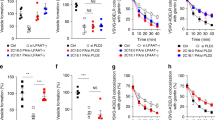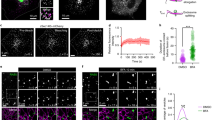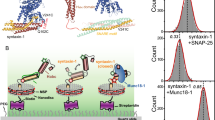Abstract
The basic reaction mechanisms for membrane fusion in the trafficking of intracellular membranes and in exocytosis are probably identical5. But in contrast to regulated exocytosis, intracellular fusion reactions are referred to as ‘constitutive’ as no final Ca2+-dependent triggering step has been observed. Although transport from the endoplasmic reticulum to the Golgi apparatus in the cell depends on Ca2+ (ref. 6), as does endosome fusion7 and assembly of the nuclear envelope8, it is unclear whether Ca2+ triggers these events. Membrane fusion involves several subreactions: priming, tethering and docking. Proteins that are needed for fusion include p115, SNAPs, NSF, SNAREs and small GTPases, which operate in these early reactions1,2,3 but the machinery that catalyses the final mixing of biological membranes is still unknown. Here we show that Ca2+ is released from the vacuolar lumen following completion of the docking step. We have identified calmodulin as the putative Ca2+ sensor and as the first component required in the post-docking phase of vacuole fusion. Calmodulin binds tightly to vacuoles upon Ca2+ release. Unlike synaptotagmin or syncollin in exocytosis4, calmodulin does not act as a fusion clamp but actively promotes bilayer mixing. Hence, activation of SNAREs is not sufficient to drive bilayer mixing between physiological membranes. We propose that Ca2+ control of the latest phase of membrane fusion may be a conserved feature, relevant not only for exocytosis, but also for intracellular, ‘constitutive’ fusion reactions. However, the origin of the Ca2+ signal, its receptor and its mode of processing differ.
This is a preview of subscription content, access via your institution
Access options
Subscribe to this journal
Receive 51 print issues and online access
$199.00 per year
only $3.90 per issue
Buy this article
- Purchase on Springer Link
- Instant access to full article PDF
Prices may be subject to local taxes which are calculated during checkout






Similar content being viewed by others
References
Cao, X., Ballew, N. & Barlowe, C. Initial docking of ER-derived vesicles requires Uso1p and Ypt1p but is independent of SNARE proteins. EMBO J. 17, 2156–2165 (1998).
Mayer, A., Wickner, W. & Haas, A. Sec18p (NSF) driven release of Sec17p (a-SNAP) can precede docking and fusion of yeast vacuoles. Cell 85, 83–94 (1996).
Nichols, B. J., Ungermann, C., Pelham, H. R. B., Wickner, W. T. & Haas, A. Homotypic vacuolar fusion mediated by t- and v-SNAREs. Nature 387, 199–202 (1997).
Edwardson, J. M., An, S. & Jahn, R. The secretory granule protein syncollin binds to syntaxin in a Ca2+-sensitive manner. Cell 90, 325–333 (1997).
Rothman, J. E. Mechanisms of intracellular protein transport. Nature 372, 55–63 (1994).
Pryer, N. K., Wuestehube, L. J. & Schekman, R. Vesicle-mediated protein sorting. Annu. Rev. Biochem. 61, 471–516 (1992).
Colombo, M. I., Beron, W. & Stahl, P. D. Calmodulin regulates endosome fusion. J. Biol. Chem. 272, 7707–7712 (1997).
Sullivan, K. M., Busa, W. B. & Wilson, K. L. Calcium mobilization is required for nuclear vesicle fusion in vitro: implications for membrane traffic and IP3receptor function. Cell 73, 1411–1422 (1993).
Conradt, B., Shaw, J., Vida, T., Emr, S. & Wickner, W. In vitro reactions of vacuole inheritance in Saccharomyces cerevisiae. J. Cell Biol. 119, 1469–1479 (1992).
Haas, A., Conradt, B. & Wickner, W. G-protein ligands inhibit in vitro reactions of vacuole inheritance. J. Cell Biol. 126, 87–97 (1994).
Ungermann, C., Nichols, B. J., Pelham, H. R. B. & Wickner, W. Avacuolar v-t-SNARE complex, the predominant form in vivo and on isolated vacuoles, is disassembled and activated for docking and fusion. J. Cell Biol. 140, 61–69 (1998).
Xu, Z., Mayer, A., Muller, E. & Wickner, W. Aheterodimer of thioredoxin and IB2cooperates with Sec18p (NSF) to promote yeast vacuole inheritance. J. Cell Biol. 136, 299–306 (1997).
Mayer, A. & Wickner, W. Docking of yeast vacuoles is catalyzed by the rad-like GTPase Ypt7p after symmetric priming by Sec18p (NSF). J. Cell Biol. 136, 307–317 (1997).
Wada, Y., Ohsumi, Y. & Anraku, Y. Genes for directing vacuolar morphogenesis in Saccharomyces cerevisiae. J. Biol. Chem. 267, 18665–18670 (1992).
Ohya, Y. & Botstein, D. Diverse essential functions revealed by complementing yeast calmodulin mutants. Science 263, 963–966 (1994).
Conradt, B., Haas, A. & Wickner, W. Determination of four biochemically distinct, sequential stages during vacuole inheritance in vitro. J. Cell Biol. 126, 99–110 (1994).
Haas, A., Schleglmann, D., Lazar, T., Gallwitz, D. & Wickner, W. The GTPase Ypt7 of Saccharomyces cerevisiae is required on both partner vacuoles for the homotypic fusion step of vacuole inheritance. EMBO J. 14, 5258–5270 (1995).
Cunningham, K. W. & Fink, G. R. Ca2+ transport in Saccharomyces cerevisiae. J. Exp. Biol. 196, 157–166 (1994).
Geiser, J. R., Sundberg, H. A., Chang, B. H., Muller, E. G. D. & Davis, T. N. The essential mitotic target of calmodulin is the 110-kilodalton component of the spindle pole body in S. cerevisiae. Mol. Cell. Biol. 13, 7913–7924 (1993).
Kübler, E., Schimmöller, F. & Riezmann, H. Ca2+-independent calmodulin requirement for endocytosis in yeast. EMBO J. 13, 5539–5546 (1994).
Geiser, J. R., van Tuinen, D., Brockerhoff, S. E., Neff, M. & Davis, T. N. Can calmodulin function without Ca2+? Cell 65, 949–959 (1991).
Brockerhoff, S. E. & Davis, T. N. Calmodulin concentrates at regions of cell growth in Saccharomyces cerevisiae. J. Cell Biol. 118, 619–629 (1992).
Weber, T. et al. SNAREpins: minimal machinery for membrane fusion. Cell 92, 759–772 (1998).
Steyer, J. A., Horstmann, H. & Almers, W. Transport, docking and exocytosis of single secretory granules in live chromaffin cells. Nature 388, 474–478 (1997).
Holz, R. W., Bittner, M. A., Peppers, S. C., Senter, R. A. & Eberhardt, D. A. MgATP-independent and MgATP-dependent exocytosis. J. Biol. Chem. 264, 5412–5419 (1989).
Steinhardt, R. A. & Alderton, J. M. Calmodulin confers Ca2+ sensitivity on secretory exocytosis. Nature 295, 154–155 (1982).
Apodaca, G., Enrich, C. & Mostov, K. E. The calmodulin antagonist, W-13, alters transcytosis, recycling, and the morphology of the endocytic pathway in MDCK cells. J. Biol. Chem. 269, 19005–19013 (1994).
Kibble, V. A. & Burgoyne, R. D. Calmodulin increases the initial rate of exocytosis in adrenal chromaffin cells. Eur. J. Physiol. 431, 464–466 (1996).
Artalejo, C. R., Elhamdani, A. & Palfrey, H. C. Calmodulin is the divalent cation receptor for rapid endocytosis, but not exocytosis, in adrenal chromaffin cells. Neuron 16, 195–205 (1996).
Vida, T., & Emr, S. D. Anew vital stain for visualizing vacuolar membrane dynamics and endocytosis in yeast. J. Cell Biol. 128, 779–792 (1995).
Acknowledgements
We thank T. Davis for many strains and stimulating discussions; B. Wickner for the start-up kit of reagents; D. Botstein for the calmodulin ts mutants; and P. Overath and U. Henning for their support and the opportunity to use their facilities. We thank O. Müller, P. Overath and B. Wickner for critically reading the manuscript and A. Glatz and C. Baradoy for assistance. This work was supported by the Boehringer Ingelheim Foundation and the Deutsche Forschungsgemeinschaft.
Author information
Authors and Affiliations
Corresponding author
Rights and permissions
About this article
Cite this article
Peters, C., Mayer, A. Ca2+/calmodulin signals the completion of docking and triggers a late step of vacuole fusion. Nature 396, 575–580 (1998). https://doi.org/10.1038/25133
Received:
Accepted:
Issue Date:
DOI: https://doi.org/10.1038/25133
This article is cited by
-
A lysosomal K+ channel regulates large particle phagocytosis by facilitating lysosome Ca2+ release
Scientific Reports (2020)
-
Intravital Two-photon Imaging of Ca2+ signaling in Secretory Organs of Yellow Cameleon Transgenic Mice
Scientific Reports (2018)
-
Dissecting the biochemical architecture and morphological release pathways of the human platelet extracellular vesiculome
Cellular and Molecular Life Sciences (2018)
-
Evolutionarily conserved BIL4 suppresses the degradation of brassinosteroid receptor BRI1 and regulates cell elongation
Scientific Reports (2017)
-
Sesterterpene ophiobolin biosynthesis involving multiple gene clusters in Aspergillus ustus
Scientific Reports (2016)
Comments
By submitting a comment you agree to abide by our Terms and Community Guidelines. If you find something abusive or that does not comply with our terms or guidelines please flag it as inappropriate.



